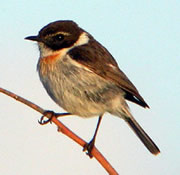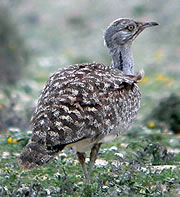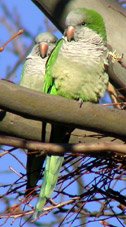 |
Spain: birds and birdwatching - part 4
by John Muddeman
Birds on Spain's islands
The main two Spanish archipelagos are the Balearic Islands in the Mediterranean Sea off the NE coast and the Canary Islands
in the Atlantic off W Morocco. Not surprisingly, due to their closer proximity and shorter distance to the mainland, the birds
 Canary Islands Stonechat male
Canary Islands Stonechat male
Saxicola d. dacotiae
© John Muddeman
of the Balearics are more similar in general to those of the Iberian Peninsula than those on the Canaries. In addition,
it appears that the greater influence of man over a longer period has probably meant the disappearance there of more species
in pre-historic (e.g. a giant barn owl and giant flightless bunting!) and historic (e.g. Golden and Bonelli's Eagles)
times than on the Canaries. That said, the isolation of both island groups has lead to the evolution of several bird species and
forms unknown elsewhere, with Balearic Shearwater and Balearic Warbler, both under serious threat being the only two
species generally considered as endemic to 'peninsular Spain'. Other subspecies are also present however, either shared with other
W Mediterranean islands (e.g. moltonii Subalpine Warbler
 Houbara male
Houbara male
Chlamydotis undulata
© John Muddeman
or badius Woodchat Shrike) or specific to the
islands (e.g. balearica Spotted Flycatcher, balearicus Blue Tit or balearicus
Common Crossbill).
The Canaries, given their affinity with other Macronesian (E Atlantic) islands and great differences in habitat between the
desertic eastern, and much more humid and forested central and western islands, show a much higher level of endemism and similarity
to NW African species. The most famous species are the various endemics, Laurel and Bolle's Pigeons,
Plain Swift, Berthelot's Pipit, Canary Islands Stonechat, Canary Islands Chiffchaff,
Blue Chaffinch and of course, Atlantic Canary. Numerous subspecies, including majorensis
Egyptian Vulture, fuertaventurae Houbara Bustard, several subspecies of African Blue Tit
(recently separated as a full species), teneriffae Goldcrest, koenigi Southern Grey Shrike,
barbarus Red-billed Chough, several subspecies of Common Chaffinch and amantum
 Monk Parakeet
Monk Parakeet
Myiopsitta monachus
© John Muddeman
Trumpeter Finch are present too, as well as other species absent from the rest of Spain, including Barbary Falcon
(increasing), Cream-coloured Courser and Barbary Partridge (introduced). The breeding seabirds (as noted before)
are also very important, while tragically, Canary Islands Oystercatcher has been lost in historic times.
Introduced and escaped species
Given the high diversity of habitats and relatively benign climate, a large number of escaped and introduced species are
also present, though only a few are currently established in significant number. The most notable are African Collared Dove
which is established locally along the Mediterranean coast, on Mallorca and on the Canaries, Common Pheasant (various areas
throughout mainland Spain and on Mallorca), Monk and Rose-ringed Parakeets (especially in towns and cities along the
Mediterranean coast), and Red Avadavat and Common Waxbill which are locally common in rice fields and river valleys
in the C and SW. More species are on the 'pending' list for acceptance onto the established list, including Pekin Robin,
Yellow-crowned Bishop and Black-rumped Waxbill and a few other parakeets which appear to be breeding too, while
Laughing Dove also appears to be established on the Canaries.
|